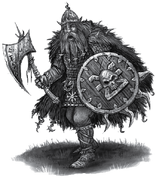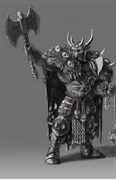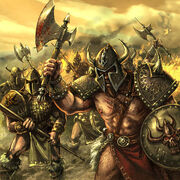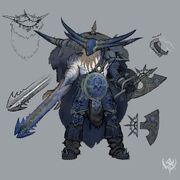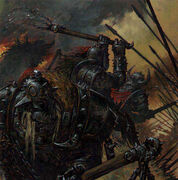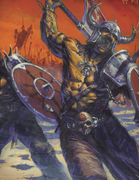"Say what you will of us, call us heathens because we deny your weak pretender-god. Call us savages because we strike at you, but know this -- it is we who are closest to the Ruinous Powers. We, most favoured of the gods shall burn your lands, revel in your suffering, and destroy you. Despair! For all that remains for you is the taste of northern steel and the end of your world. Such is the will of the Gods."
- — Hallbjorn, Norse Marauder
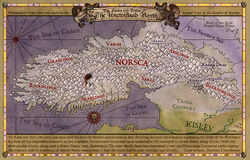
A Map of Norsca
Norsca is a harsh, deathly peninsula located in the far north of the world, populated by the Norscan tribes. It is a ferocious land steeped in the mutating energies of Chaos due to its proximity to the Chaos Wastes, known amongst the Northern tribes as the Shadowlands. Norsca is populated by a fierce and hardy race of barbarians known collectively as the Norse, or Northmen, merciless reavers who fight in the names of the ancient gods of the north. The Northmen of Norsca are without exception great warriors, blessed with incredible strength at arms and fierce demeanors. It is the dream of nearly every Norsemen to join the ranks of the greatest warriors -- to become Champions of Chaos and bear the marks of their Dark Gods.
Hard-bitten and war-like, the men of Norsca are the very epitome of the Warriors of Chaos.
The Land
"I spent a year in that hellish place. Can you believe it? For six months straight, it was dark, the sun barely came over the horizon. And let me tell you, those were the most dangerous six months of my life."
- — Mikel Kraus, Mercenary
Geography

The Chaos-tainted wastes of Norsca are the bane of the weak
Norsca is, for the most part, a frozen wasteland stalked by all manner of gruesome monsters. Such as Trolls, Giants, and nameless things that dwell beneath the mountains. Few crops grow here, for the land is as hard as iron and the howling winds cut like daggers of purest cold. A network of fjords and mist-clouded isles wreath the coasts, and it is from here that the Northmen build and tether the longships with which they terrorize the shores of the known world. Scattered coastal settlements provide some respite from the harshness of the elements, but even they are regularly assaulted by Bloodkrakens and other such horrors. Further inland, the land gives way to frozen steppes where tribesmen hunt their game, taking care to avoid the bone-carpeted lairs of ice drakes. It is a grim, shadowy land where the weak do not live long. And where living means a constant fight for survival, supremacy, and the chance to appease the Dark Gods.
The seas of Norsca are even less hospitable. Black longships prowl the coast, mastered by terrible Chaos Champions. From the ports and fjords of Norsca the Chaos Reavers sail; eager to set the lands of the south to the torch. The icy waves of the Sea of Claws is itself as much the bane of sailors as the Chaos Marauders who sail it on their longships -- with winds so cold they freeze the very spray, causing knives of frost to pierce the flesh and freeze extremities. It is a frozen, hell-stained realm of violence and scarcity, which breeds the Norsemen into some of the fiercest and most violent warriors to blight the earth,
The country is famed for its foreboding mountain peaks, such as the Jotunheims and the Mountains of Thjazi -- the mountains themselves are often cloaked in myth and history, often named for legendary creatures and towering Chaos Fortresses atop their icy peaks. Though they dominate the terrain, there are also mssive stretches of dark pine forests doting the slopes, and some stretches of open plains and sections of frozen steppes. Norsca also has glacial seas of pack ice that stretch down from the Northern Chaos Wastes. These ice fields form the Frozen Sea along the north. Beyond the eastern arm of that body of water lie the northernmost portions of the Eastern Steppes, where dwell the Kurgans -- the dark-skinned horsemen of Chaos, cousins to the Norscans and fellows to them in the worship and adoration of the Chaos Gods.
In the summer months, the air warms just enough to enliven the stretches of open plain that serve to supplement the Norsemen's diet of fish and bear-meat. All other months, the land is deathly cold and unnatural snow-storms are a constant. Made worse by the unholy winds blowing down from the North from the Chaos Wastes. Half the year is a dim twilight, the sun is barely a disk of light hanging low on the horizon. Within the land itself lies things warped and changed by the loosed energies of Chaos that permeate this ancient land. Though there is however wealth hidden amongst its terrible dangers -- the mountains that hide veins of gold and iron and other precious metals. And then there is Warpstone -- the very essence of Chaos given form in the world, hardened essence of pure Change: the very land is suffused with it. All these treasures provide a lure for the courageous and greedy to make the journey north and risk their to risk their lives under a Norseman's blade, and their immortal souls upon their bloody altars.
Landmarks
Aside from the natural features of this land, Norsca has a great many constructions dotting the landscape, erected by the savage Norsemen who call this dark land home. Massive Chaos Monoliths are a common site throughout the land: blasphemous constructions of stone raised to honour and commemorate the lives of great Chaos Champions who have either died in battle or have ascended to daemonhood. In addition to their function of remembering the lives of great Norse heroes, the monoliths also function as markers of tribal territory. An example would be the Monolith of Borkill the Bloody-Handed, raised by the champion's fellow Skaelings to honour his victory over a Bonegrinder giant, or the Monolith of Kjarl Deathaxe, built on the shores of the Chaos Wastes to honour the Khornate Champion.

The interior of a Norscan meadhall
The Norscans are also famed for their great halls; immense buildings where the tribes feast and fight and muster for great invasions upon the coasts of the Old World. The most famous of these is the Hall of the Snaegr, located in southern Norsca in the Skaeling tribal lands. It is home to the Snaegr tribe, devout and favoured followers of the Chaos God Khorne. One of the greatest chieftains of the Snaegr, Ulfr by name, was such a powerful champion that Khorne bestowed upon him Daemon Princehood. Now known to his tribesmen as Ulfrdaemonkin, they summon this lesser daemon god to impart the Blessing of Khorne upon their current chieftains in an ancient ritual as old as Chaos itself. Another example is the great Hall of Urslo in the Ursfjord; home to the fierce Tribe of the Bear led by the Chaos Champion Beorg Bearstruck.
In addition to all this, Chaos Citadels are also erected by the Norscan tribes, where the most powerful chieftains dwell. There are three ones known to have been constructed in Norsca: the Forbidden Citadel in Aesling lands, the Doomkeep in the lands of the Vargs, and the Tower of Khrakk in Baersonling lands. There is also the Altar of the Crimson Harvest, located in the extreme south of the country, overlooking the northern shore of the Sea of Claws.
The Norscans
"From the harsh snowlands they come, blue of eye and blonde of hair and tattooed upon arms, face and chest. Their eyes are mad with bloodlust, for blood they thirst, driven forth on the whims of the gods they seek to appease. Clad in few garments and wielding clumsy and brutal axes and maces, they rage against the civilized lands of the south, burning, pillaging and looting all before them as a sacrifice to their uncaring masters beyond the gates of hell in the northern wastes."
- — the Liber Chaotica, penned by Richter Kleiss, Priest of Sigmar, declared insane
The Norse are a distinctive race. Possessed of tall, broad frames and extremely muscular builds, they are built for warfare and thought to be some of the strongest warriors in all the world. They often cultivate great masses of facial hair and wild beards, which they often braid and plait in a manner somewhat reminiscent of the Dwarfs; the Norscans are extremely proud of their beards, considering them as indicators of strength, virility and manliness, and those are without beards are often mocked and harangued in their masculine society. They tend to have fair hair, such as red and blonde, but darker hair colours are also fairly common amongst them. Norscan warriors often festoon tribal fetishes upon their person, such as the teeth of beasts, the heads of powerful enemies and talismans said to invoke the power of the Dark Gods. Most Norscans also bear tattoos and scarifications displaying their fanatical devotion to Chaos. The folk of the Empire know the Norse as those who sail their longships to attack the southern lands, clad in fur and steel, a fierce race whose sons love nothing better than to charge into battle wielding sharp axes.
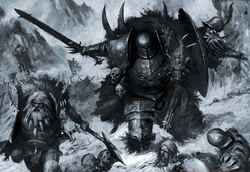
The Norscans are a fearsome people
Over the centuries, the marauders from the above the Sea of Claws have always targeted Kislev and the northernmost lands of the Empire. The raids of the Norse have become increasingly brutal and deadly as the taint of Chaos has spread across the northern wastes. In times gone by, the battle-hardened Norsemen and Kurgans would forcibly settle the lands they jointly conquered, taking a local wife. Over time, as the grip of the Chaos Gods upon the world has increased, their influence in the northlands has increased exponentially.
The taint of Chaos is ever increasing and has ever been strongest in the North, due to its proximity to the gateway to the Realm of Chaos at the northernmost point of the world. For this reason, the hard warriors of Norsca have ever worshiped the Chaos Gods. even if the names of these gods have been warped and twisted along with the minds of the Norse. While all the tribes recognize the Chaos Gods as their masters, they may pray and shout to a different name. Ultimately, however, it is always the Ruinous Powers who are listening and responding to their cries.
Thus, raids from the north seek not only to take gold, women and food for the sake of survival, but also to shed blood for the Gods. When the fur-cloaked warriors of Norsca emerge from their dreaded longships, their objective may not be to simply pillage, but to kill, maim and destroy in the names of the Chaos Gods.
The Norsemen are in a constant state of warfare. Both with each other and the other northern races, as with the civilized lands of the south. In ice-bound Kislev, where the border is less constant than the sea, the Ice Queen, Tzarina Katarin, has had to continuously reinforce the defenses of the frontier cities of Praag and Erengrad against the utterly staggering ferocity of Norscan attacks. In spite of their unbridled savagery, a few facets of society remain. Namely; honour and loyalty. Particularly to one's kinsmen and allies. Few Northmen dare to displease their chieftains and tribal elders, for doing so risks being thrown into the wilds, with little hope of being accepted by another tribe.
The Norsii
In the northernmost lands of what is now known as the Empire lived the Udoses and Roppsmenn tribes. Further north, beyond any of them, beyond even the Forest of Shadows, dwelt the Norsii tribes. Barbarians and worshipers of the Dark Gods who had come down from the Far North and settled the inhospitable extreme north of the Reik Basin. The Northmen were brutal warriors; savages even by the standard of the other tribesmen who dwelt in the lands. Iron warriors, possessed of indomitable strength and power, utterly without mercy. Feared and hated for their brutality and their zealous worship of the Dark Gods, the Norsii made prey of the weakling tribes of the south, who had no defense against the great power the gods of the North bestowed upon them. The legends of the time of Sigmar describe the depredations of the Northmen in no uncertain terms; speaking of towering warriors in black armour and horned helms, wielding great jagged axes and shields taller than any man, and towering horsemen on great destriers.
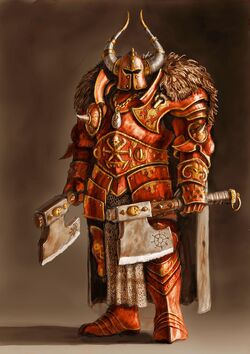
A Norse Chosen in service to Khorne
Masters of the fearsome Wolfships, the Norsii raiders were the terror of the northern coastlines. Leaving only death and smoking ruin in the wake of their catastrophic invasions. When these barbarous men invaded the holdings of the Cherusens and Taleutens, not even the combined strength of those two tribes could hold back their dark fury. Indeed, the Norsii warriors were so ferocious that even the war-like Teutogens were wary of challenging them at their full strength -- deigning instead to wait until the Norsemen had exhausted themselves slaughtering the southerners and then swooping in to claim the ruined lands they would inevitably leave. In the end, it took no less than a coalition of the Unberogens, Cherusens and Taleutens to stand against the Norsii. Even though outnumbered, the Norsii fought with insane might in the hopes that their Dark Gods would notice their bravery. The southern coalition drove back the northern madmen, but the valorous King Bjorn Unberogen, father of Sigmar, was slain in the battle. A terrible blow to all the tribes of the south, not only the Unberogens.
The Norsii's reign of terror was finally ended when Sigmar rallied the tribes of the south and drove them back beyond the sea to their forsaken ancestral homeland of the North, after they once again invaded the lands of the Udoses, in what is now Ostland. Against such a powerful foe, not even the Norsii could withstand, and so they were forced to retreat to north, slaughtering their way through the Ungols and Kurgans, to the land that would later be known as Norsca. There they marshaled their forces, raided the neighboring races for plunder and resources, and nursed an even greater hatred of the men who had ended their path of conquest.
In the 9 IC, the Norsii would return in force with all the fury of their Dark Gods behind them. Rallied behind the leadership of a great chieftain and Champion of Khorne known as Cormac Bloodaxe, the Norsii raided the northern territories of the nascent Empire just as they had before; enslaving the Roppsmenn tribe to their will and launching a devastating attack on the Udoses tribe, killing their chieftain Wolfilla - himself a count of the Empire - and throwing the northerners into disarray. With the defense of the north shattered, the Norsii were able to strike further and further into Imperial lands, spreading terror and destruction everywhere they went.
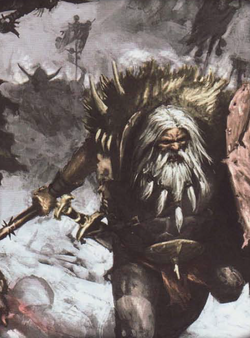
The vicious Norsii were the first warriors to defeat Sigmar in open battle
This was only exacerbated by the fact that when Sigmar learned of the Norsii invasion, and the Roppsmenn's complicity in it, he marshalled his forces and waged a long, ardous campaign to crush them and drive them out of the Empire, for they had forfeited their place in it by aiding the savage Norsemen. This left the inner lands of the Empire also undefended against the wrath of the Northmen. The Roppsmenn tribe was all but annihilated by Sigmar, their remnants driven into the then unknown lands of the east where they would come into conflict with the Ungols.
When Sigmar finally faced the Northmen, they had done what no other enemy had accomplished ever before or since -- they handed Sigmar his first and only military defeat. He had expected undisciplined berserkers, only to find the natural ferocity of the Norsii tempered by a razor sharp military precision. Even the whirlwind fury of the Thuringian berserkers was little compared to the merciless battle-rage of the Norsii warriors, who met the Thuringians and hacked them apart, almost managing to slay their King Otwin. The axes and swords of the Norse were not the only foe Sigmar faced that day, for the Norsii had also enslaved the Kurgan and Hung tribes to their service, and so did the horsemen encircle Sigmar's host, hammering them with arrows while the Norsemen charged their lines, smashing into the southern warriors like the fist of the Blood God himself.
Faced with such opposition, Sigmar and his warriors retreated to Middenheim, forcing the Norsii into a long, protracted siege. Though the toll was high, the Empire eventually triumphed, when reinforcements from the other tribes converged upon the Norsii and defeated them. Once more, the Norsii were thrown back across the Sea of Claws, to the land of Norsca. Where their descendants live to this day, warring with each other and continuing to venerate their cruel gods, whose names civilized men do not speak.
The Norsii invasions would continue, however. Not only upon the Empire but also upon the Bretonni horse tribes of the west. Several years after the Norsii invasion of Middenheim, a new offensive would spill out of the north that would dwarf it in intensity. From the scattered Norsii clans rose a single warrior -- the now legendary First Everchosen, Morkar the Uniter of the now extinct Taalos tribe, who was orphaned as a child by Sigmar's reprisal raids against the Norsii. Filled with vengeance, imbued with the power of the gods, and charged with the mission to establish the mortal realm as a kingdom of Chaos, the warrior-king led his armies against Sigmar's Empire, reaping victory after victory until he finally cornered Sigmar in single combat. In a battle likened between gods, did Ulric's Chosen and the Lord of Chaos match their arms against each other. But in the end, Sigmar overcame Morkar, and the Norsii and their allies were again driven back to their tainted homeland in the north.
The Norscans Today

Norscan warrior
The Norscans, as they came to be called after settling in the north, have earned a reputation as relentless warriors feared throughout the Old World. In the past, they have invaded and conquered parts of the Empire, ruling areas there briefly before they return to their blasted fastness in the far north. An example of such is of Snorri Half-Hand, son of High-King Ormgaard, who ravaged and conquered the Wasteland with a horde of Marauders at his back in 1109 IC, renaming the area as "Vestland", and proclaiming himself Jarl. The later advent of the Black Plague two years later led to the Norscans abandoning the city of Marienburg. Over the centuries, however, the Norscans have conquered, ruled and destroyed Marienburg no less than four times throughout history.
Another example is of the brief Norse rulership of Nordland, where the Norscans brutally conquered the northern province and ruled it. The Empire was incapable of sending forces to liberate Nordland as a result of the Great Plague. Due to this, Norscan longships colonized the Nordland coast unimpeded - enslaving the native Nordland population. Emperor Mandred Skavenslayer, pre-occupied with other threats, could also not answer their pleas, much to the horror of the northerners. It is often said, that as a result of living under the shadow of Norscan invasions, the Nordlanders have become somewhat Norscan themselves, with all that implies.
Yet the Norscans are most feared for the zeal with which they fight in the names of the gods of the North. In the year 2515 IC, a massive Chaos incursion poured out of Norsca, led by the fearsome Chaos Champion Lord Mortkin, one of the Sea-Kings of Norsca. The invasion was launched in retribution for the destruction of various Norse towns along the Norscan coast perpetrated by the Elector Count of Ostland, Valmir von Raukov. The Norscans ravaged most of Ostland and burned down the great cities of Volganof and Kludburgh as wergild for the destruction of their settlements. The son of the count, Oleg von Raukov, was also slain in the invasion. In this terrible invasion, the Norsemen came terrifyingly close to destroying the Empire itself.
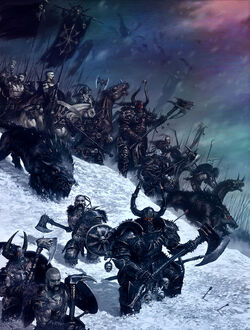
Norse warhost
In Sigmarzeit 2398 IC, one of the dread lords of Chaos, a legendary warrior-queen of Norsca known as Valkia the Bloody, consort to Khorne the Blood God himself, called the Northmen to take to their longboats and follow her across the Sea of Claws to wage war once more upon the people of Nordland. Valkia and her tribe fell upon the northern provinces like sea wolves, their purpose not to enslave the Nordlanders, nor to enrichen themselves upon the spoils of their raids, but simply to shed blood in honour of the Norscan god of battle. Neither man, woman, child nor even livestock was spared sacrifice to the insatiable Blood God. The Norsemen were eventually driven back by the intervention of the Dwarfs, but the ruination and plunder the Northmen had visited on Nordland meant that only the hardiest men of that province survived the coming winter.
The Empire is not the only nation to endure the depredation of the Chaos reavers, Kislev as well has suffered from Norscan attacks in the past, being the border realm between the south and the terror of the north. During the Great War Against Chaos in 2302 IC, a mighty Chaos Lord known as Sven Bloody-Hand, lieutenant to the Kurgan warlord Asavar Kul, sacked the great port city of Erengrad before escaping back to the sea. More generally, Norse Chaos incursions from beyond the Chaos-tainted wilderness of Troll Country are a constant threat to the Kislevites. Though these attacks are mostly confined to small scale raids, on occasion a powerful chieftain will arise in Norsca and bring the tribes together for a great invasion into the realm of the Ice Queen. Despite their reputation as fearless marauders, the Norscans have come to be wary of the Ice Witches of Kislev, and to kill one of these powerful spellcasters is a cause for the Northmen to celebrate with gory and spectacular rituals invoking the Dark Gods. Much like the Nordlanders, the Kislevites are often the first to die to the jagged axes of the Norse.
The Norse also have come into regular conflict with the Northern Dwarfs of Kraka Drak. In 2302 IC, roughly concurrent with Asavar Kul's invasion, the Norse High-King Valmir Aesling declared himself to be the "Emperor of Chaos". Valmir was a ruthless and efficient leader of men, brooding and silent save for the often fatal burst of temper. He punished cowardice and insurbordination with the most gruesome tortures he could devise and hated all the races of the Old World, including the Dwarfs, with a fiery passion. Valmir waged an ardous campaign of 88 years but managed to annihilate the hold, albeit at the cost of his own life. Similarly, in the year 1396 IC, the Norse overran the Northern Dwarf Hold of Karak Ghulg under the command of Valkia the Bloody, The Shield-Maiden ordered her fellow warriors to perform a grotesque act upon the defeated Dwarfs. They unfolded their enemies' bloody ribs, made naked their hearts and spread out their lungs. With their bleeding lights about their bodies, the Dwarfs appeared as though they had bloody wings, and so this vile execution was named the "Blood Raven", and continues to be used by the Norsemen.
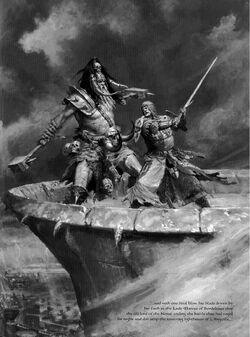
A Norscan warrior faces a Lord of Brettonia
Clearly, it would be easy to say that the Norsemen's relationship with the southern world is one of constant war. And it is, mostly, given the Norse propensity for combat and bloodlust. Yet despite that, there are instances that show the Norse approach to the Old World may not always be one of war. Though typically larger and more powerful, the Northmen are not completely unlike their cousins to the south. In times of peace, it may be possible to see a trader from the North hawking his wares in the great markets of Marienburg, just as it is likely to see a Kurgan or a Hung trader do the same in the Cathayan merchant capitol of Weijin to the East. Yet in all other respects, the Norse are a people apart from all others -- for their culture is one based on eternal battle, blood and human sacrifice, their gods the gods of the End-Times, and they are amongst the most feared race of Men in all the world.
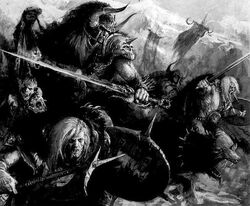
Raiders from the North
The Northmen are also explorers of incredible skill, as their longships allow them to range far south and west. In 888 IC, the infamous reaver Losteriksson discovered the strange tropical land of Lustria in the New World; establishing the outpost of Skeggi upon its mangrove lined shores. In time, Skeggi became a mustering point for many Chaos Champions from Norsca and their bondsmen as tales reached back north of battles against the Lizardmen of Lustria, as well as of the great riches to be found in the new land. In 954 IC, the Champions of Skeggi sailed back to their homeland, bringing with them such tales and then returning to the continent with a great army of raiders. As the conflict intensified, more Warriors of Chaos from frozen Norsca sailed to the warm lands of the far south; driven by the lust for gold as well glory. The Norsemen, being fierce men of the Far North, carried with them their Dark Gods in their hearts. A power not felt in Lustria since the Fall of the Old Ones centuries ago, the Slann-Priests, their meditations troubled with echoes of the distant past reverberating from one mage-priest to the next, now knew that the Chaos Gods were again abroad in the world once more - their banner carried in their war-like souls of these mighty warriors.
Most significantly, the Norscans have ever been at the forefront and vanguard of the Great Chaos Incursions, serving as warriors and leaders. Indeed, whenever the shadow of Chaos spreads, the Norsemen are among the first and foremost to take up thier blades and rampage south. Since then, the Norse have always served as the backbone of the great invasions from the north. When the gods' make the call to war they leave their settlements in force, eagerly marching beside the steel-clad Chaos Warriors and Knights who have risen from their ranks. They are the vanguard and spear-head of the Chaos Hordes, battering aside all opposition and clearing the way into the Empire for the Kurgan horsemen of the east.
Now, with Champions of Norsca each serving as Archaon Everchosen's four highest lieutenants, the Norse stand ready to heed the call of their Dark Gods and usher in the final glorious battle that will bring the final end to all things.
Norscan Culture
"I pity you and all the world, that of all the races of Men, for the Gods favour we Norse alone."
- — Haubr, Norseman
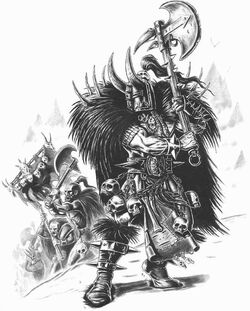
To see such men on the battlefield is to see death made flesh
The Norscans, as a cohesive people, do not exist. They are instead divided into various, numerous tribal confederations that are as much at war with each other as they are with the Kurgan tribes to the East or the Empire to the South. These various Norse tribes are often nations unto themselves: possessing varying pantheons of gods, traditions, heroes and tribal dialects. However, all are united by a shared ancestry and veneration of the Four Dark Lords of Chaos.
The main tribes of Norsca, from which all others descend, are the:
- Aeslings
- Graelings
- Vargs
- Sarls
- Kvelligs
- Hastlings
- Bjornlings
- Skaelings
- Baersonlings
There are also lesser tribes under them, such as the Gorehunt, Snaegr, Sortsvinear, Ironpelt, Brennuns, Crow-Brothers, Wolfclaw, Stormravens, Wyrmkin, Kin-Slayers, Beast-Flayers, Blackaxes and The Scourge of the North led by the champion, Volrung Axblade.
The tribe forms the very core of Norscan identity. A Norscan will never identify himself as such, indeed, the very term "Norscan" is an Imperial labelling, and a Norseman will instead identify himself based on his tribe and lineage. For instance, an Aesling will always think of himself as an Aesling -- for their only loyalty is to their family, kinsmen and to the Dark gods.
The Norse tribes are further distinct by their manner of worship, garb, battle-customs and beliefs. For instance, one of the Skaeling tribes of Norsca dress in bearskins and reindeer hide clothing adorned with charms and embroidery, and cut their hair into strange shapes died red and held up with animal fat. They sport tattoos, runes and scarifications all over their muscular bodies invoking the protection of the gods, and dye their shields red (often with blood) in honour of Khorne, the Blood God and their patron. Their tribal colours are red and blue; to honour Khorne and their proud heritage as sea-raiders without equal, respectively. These Skaelings have taken the symbol of Khorne as their own, indicating their piety, and tend to prefer mighty axes and spears above all other weapons in order to further please the war-waging god.
Battle and faith are at the heart of Norse society. The tribes live for war and the shedding of blood, and the rivalries between them provide ample opportunity for it. Men in Norse society earn standing by being great warriors, and thus earning the favour of the Dark Gods as a result. Thus raids from the north are undertaken in part so that young men may advance in honour in the eyes of their fellow tribesmen and, more importantly, the Chaos Gods. Slaying the weakling warriors of the south, despoiling the temples of southern gods, and carrying prisoners back to the north to be sacrificed upon pyres and altars dedicated to Chaos all serve to advance a Norseman's renown. Oral traditions and sagas are also important in Norscan society, deeply intertwined with the aforementioned need for social standing through raiding. It is the dream of nearly every Norseman to have the deeds of his life remembered and feared by all through their recording in the sagas sung by the skald-chanters. Most of the warriors commemorated in the sagas are legendary - some even near mythical - champions of Chaos. Some sagas are even written in the honour of whole tribes who committed glorious feats of strength - such as the Saga of the Gorehunt tribe.
Honour in Norsca is highly integral, and most feuds among the tribes can likely be traced back to a breach against a man's personal honour by a person from the other tribe, though who did what exactly will likely depend on which side of the conflict one asks. The Norsemen guard their prestige jealously and are even willing to endure horrific torture and long lasting injury if it means their honour is protected.
Norscan Spirituality
""Khorne!" they roared, invoking the sacred battle-name of Kharnath the Blood God, Lord of Battles. "Khorne!" they howled until it seemed the walls must fall from the violence of their voices alone. "Khorne!" they shrieked as they gnashed their teeth and bit their shields."
- —Destruction of Wisborg
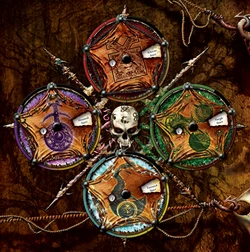
Norscan religion revolves around the worship of the Chaos Gods
Norscan religion is based primarily around the worship of the Chaos Gods, by the various names the Norscans know them by. Commonly, the Norscans (like the other races who dwell around the Chaos Wastes) venerate the Chaos Gods in a pantheon, as a purely practical consideration, to draw upon all of their gifts and powers to better survive in the harsh north. However, many tribes do take a single Chaos God as their patron, who is seen as both the father and protector of that tribe, as well as the chieftain's own patron. In addition to the Chaos Gods themselves, the Northman pantheon also incorporates various Greater Daemons, fallen Chaos Champions, ancestors and various other lesser spirits into its traditions. However, it is always the Chaos Gods are ever-present and who receive the highest degree of veneration; being the core set of deities Norse religion revolves around. In the Norscan faith, there is no equivalent to the Kingdom of Morr, there is nothing after death save the Realm of the Dark Gods, and men shall only enter that holy place to sit at the right hand of their gods if they were strong and true warriors in life. Cowards are cursed by the gods and reviled for all eternity. Thus, every Norscan fights with an insane fervour driven by this belief, which molds them into the perfect warriors of the Dark Gods.
In battle, the Norse look to Khorne, the War-God for strength. Shaman and vitki look to Tzeentch, the Raven, to unravel the mysteries of magic. In times of plague, the Norse offer sacrifices to Nurgle, to placate the Crow-God and to persuade him to withhold his "blessings." The Norscans see themselves as the closest of all the races of men to the Dark Gods, and thus see it as their duty and right to raid and ravage, and not only the south, but also their fellow worshipers of Chaos -- such as the Kurgans and Hung to the east. Many Norscan warbands also make journeys into the Chaos Wastes, to hunt the abominable creatures of that land and show their might to their infernal masters, indeed, amongst some tribes, there is a tradition of leaving a child on his thirteenth year at the shores of the Wastes with only bare necessities and a single weapon, if he is able to survive for a week, he is returned and made a man of the tribe, if he manages to bring back the head of a Chaos Spawn or a Beastman, then he is made a warrior then and there.
The Norscans honour the Chaos Gods for their might, and for the might they bestow upon their chosen people, seeing the blessings the Dark Gods bestow as gifts of great power that are necessary in order to survive the harshness of the north. All Norscans are to some extent affected by the power of Chaos, and so they see the work of their gods in all things, and are always vividly reminded of their potency. In comparison, the gods of the south, such as Ulric, Sigmar and Myrmidia are pitiful children before the might of the Dark Lords of the North. In general, the Norse tend to revere Khorne, the Skull-Lord, Brass-Lord of Battles, more fanatically than the other races of Chaos. For the simple, brutal strictures of the Blood God's faith are pleasing to the Norse, and the behavior of the various Norse tribes in Norsca as well as the terrible Troll Country dovetails neatly with what the Blood God expects from his followers. As a result, many tribes of Norsca take Khorne as their sole patron and most Chaos Shrines dedicated to him are found within Norse settlements. The Norscans also maintain a unique tradition in their version of Khornate worship, holding up the veneration of the Daemon Princess Valkia the Bloody. According to Norse sagas, she was once a fearsome warrior queen of one of the tribes of Norsca who was risen from her tribe to become the Shield-Maiden of the Blood God and the Bringer of Glory -- Khorne's consort who chooses the valiant dead who are to enter into the Halls of the Blood God to fight on for all eternity. Many times in the past, Valkia has returned to the mortal plane to lead the Norscans to battle, and in her presence, the grim warriors of the north fight even harder - for where Valkia flies, the Axe-Father watches, and to any Norscan, the prospect of becoming his Chosen is a prize beyond all measure.
Indeed, the Norscans' utter devotion to Khorne is a dark thing of terrifying fanaticism, for they have gone above and beyond the call of their god's demand for eternal warfare. Thus, many Norse tribes spend their days raiding up and down the coastlines of the Empire and beyond to gather skulls to honour the Blood God. An example of the Norscan Khornate zealotry is of the Gorehunt tribe, who in late 2103 IC, resolved to offer up the skulls of far-off lands unto the Blood God, and took to the seas on their longships, heading to the south. The Norscans eventually came across the desert kingdom of Araby. Though the tribe was less than a hundred strong, the Norsemen were truly blessed by Khorne, and carved a bloody path of devastation throughout the land, battering aside the many thousand-strong armies of the Emirs of Araby. Finally, the rulers of that kingdom sent an army so great it hid the very dunes of the desert with its passing, and numbered great creatures of magic in its number. But the berserking Norsemen fought on with an iron resolve and annihilated the army, spilling so much blood it ran in a mighty river throughout the desert kingdom. Though every Norscan of the Gorehunt tribe was slain, their strength and devotion pleased Khorne greatly, and he willed it so that the river of blood they spilled would forever run through Araby as a testament to their devotion.
Executions
Virtually every man of the Norscan tribes is a warrior, and amongst warriors it is likely that the worship of Khorne, the Norscan God of Battle, will take root. Amongst the savage Norse, there is barely a tribe whose warriors do not include devotees of the Axe-Father, and it is from the Norscan devotion to Khorne that the grotesque practice of the Blood Raven originated. In 1396 IC, Valkia appeared before a tribe of Norse warriors led by the Chaos Champion of Khorne: King Bothvar. Bothvar and his tribes had been waging a long war against the Norse Dwarfs to gain the pleasure of Khorne. Valkia appeared before him, an auspicious event for any devotee of Khorne. Valkia told Bothvar that while Khorne was pleased with his killing, he could yet do more to secure the favour of the god of war. Thus, Valkia taught the Blood Raven, which was then used by the Norsemen upon the Dwarfs. The first recipients of the gruesome execution.
The Blood Raven is an ancient torture, stretching back at least eleven centuries. Reserved by the Norse for their most hated enemies. It involves flaying the skin from the enemy's back, exposing the meat and muscle beneath. Then the ribs are bended outwards until they break. After that, the lungs must be ripped out and placed on the upon the shoulders, causing the tortured creature to appear as if he or she has bloody wings. Among some tribes, this torture is also known as the Blood Eagle.
Another sadistic punishment, one said to be shunned even by the Nurgle, is putting a snake in the belly. Fairly self-evident, this torture involves a snake, a metal pipe and a torch. The captive's mouth is wrenched open and the metal pipe is inserted down his or her throat. A snake is then unleashed and is made to slither through the pipe into the captive's throat. The torch is used to heat the pipe, thus encouraging the snake's progress. It is a slow, lingering death that is reviled even amongst the men of Norsca.
Wergild
It would be easy to decry the Norsemen as being lawless savages, with no care for the destruction and carnage they leave in their wake. Truly, they are a savage people; who have little interest in other races beyond slaughtering or enslaving them, and who openly worship the Dark Lords of Chaos. However, to decry the Norsemen's society as lawless is simply false. Favouring simple laws over the complex ones favoured in the Empire and elsewhere, the Wergild is one of the few universally accepted traditions of Norsca. To put it simply, the weregild is the price paid by a murderer to the family of a victim of murder, or to an injured party in compensation for some other crime. Wergild can be in the form of silver, cattle, slaves or even steel, some payments can be far more brutal, however - such as the cutting of limbs or the carving of flesh, depending on the arbitration of the Jarl presiding over the matter. The price of wergild depends on the importance of the individual killed or slighted, with Kings and Jarls occupying the highest echelons of importance in Norse society (though how one could face these terrible Chaos Champions in battle is hard to see), and thus the highest price of compensation.
The manner in which the wergild is paid out varies amongst the tribes. Certain times, the arbitration of wergild may involve a transfer of titles and station to the wronged party, and there are even some cases of Norsemen taking the women, children, holdings and even the thralls of their enemies as recompense for losing their own as a result of the accused's actions. Other times, the wergild may not even fall on the guilty party, but instead on a relative -- such as a wife or child, who will often have to part with a limb or eye to repay the debt of the patriarch. Sometimes, it may even pass upon the next person to enter the area, a preferred arrangement for the accused, but often a risky one if a man of importance, such as a Jarl, is the one who enters.
The shaman of Norsca, however, have no worldy wergild attached to them. Rather, it is the wergild of the gods that their foes must pay. As the gods are very active in Norscan society, shaman occupy a high level of importance and afforded a great deal respect, seen as the oracles through whom the gods communicate their holy will (of course, as the Norse see spirituality as a matter directly between a man and the Chaos Gods themselves, no self-respecting Northman would depend on a middle-man to speak with his own deities). Thus, no warrior of Norsca would dare raise his hand against a seer, for even the fearsome warriors of the north fear the retribution of their gods.
Norse tribes dedicated to the Master of the Skull Throne have no reverence for spell-casters such as Chaos Sorcerers, and invariably slay such seers whenever they find them. To compensate for their dearth of arcane knowledge, Norsemen trbes who worship the Blood God have their own form of Seers; a sect of terrifying warrior-priests known as Bloodfathers. These Norsemen are legndary warriors who bear the Mark of Khorne and receive are said to receive visions of bloodshed and knowledge of battle from him. For even a devotee of Khorne to raise his hand against them is said to invite the displeasure of an already raging god. The Bloodfathers of Norsca are rightly feared throughout the North, for it is said that there is no trick of axe and sword that Khorne has not revealed unto them.
Norscans in Battle
"And then those sails appeared on the horizon. White, but dripping with the bloody symbols of their foul gods. And then came the black wood of the boats, dragged through the froth by tireless, muscled arms pulling on a hundred oars. I rang the warning bell from my lookout and me lads formed up, each one sweating at the arrival of these beasts. The crossbowmen loosed bolt after bolt, and many fell, but still the howling fiends ran up the beaches with no care for armour or shields. They looked like rabble, but fought like daemons, crashing through our lines, butchering men left and right, clubbing limbs into gore and hacking heads from bodies like they were attached with butter. I'll never forget that morning...""
- — Account transcribed from an Ostland sergeant, 2517

The Norsemen are the epitome of the Chaos Hordes
The Norscans have a wholly deserved reputation for being incredible fighters. And when one reviews the facts, it becomes rather obvious why. Their homeland is a haunted waste infested with terrifying beasts such as Chaos Spawn and trolls, infused with the very essence of Chaos and lashed by furious, freezing winds. Their gods are terrifying idols of darkness, who favour only the strong and demand the destruction of the weak. To their east are the bloodthirsty horse-nomads, to their south are the heirs of the greatest enemy and to their north, the very abode of their gods. Norsca is a land where living even a single day is a victory. And the Norse do not simply live, but thrive under the very shadow of the Chaos Gods, and have thus become one of the most feared races of men in all the world.
The conditions of their environment and the strictures of their faith have forged them into a true warrior race. Each northman towers over any man of the Empire, their powerful bodies hardened by lives of ceaseless toil and endless war. The Norsemen fight for survival from birth, and all of them bear the experience of hunting and fighting in the frozen wilds of Norsca. Their legendary endurance and strength has been built by centuries of living in a land that does not tolerate weakness, and has been further bolstered by the powerful influence of Chaos that affects all those who live so close to the Wastes.
In battle, the Norscans invoke the war-god Khorne, from the lowliest marauder to the highest Chosen (provided he does not serve an opposing power, of course). By bellowing and roaring his dark name, the Norsemen drive themselves into an uncontrollable battle-fury -- whether by their own will or that of Khorne, who can say. The blood-crazed Khornate berserkers of Norsca are truly fearsome opponents, and many thousands have been undone by their psychotic, blood-lusting fury.
Whichever one of the Four they worship, every Norseman is a fearless warrior. When set loose on the battlefield, each marauder is like a beast scenting blood, and they will not rest until their lust for death is sated. For they know that the eyes of the gods are upon them, judging their strength and testing their courage. They know too that those who fight well will be honoured by the gods, and will receive their blessings and the marks of their favour. And so they fight with no regard for their own lives, only for how many they can end on the battlefield. Death, afterall, is the destiny of all, and so when it comes, the Norse do not court it like the weak men of the south, but rather embrace it when it comes. An end with blade in hand and the red ruin of their foes all about them -- an end to make both gods and ancestors proud; the men of the North fear dishonour more than the touch of the valkyrie.
Norscans observe various customs and rituals before battle; done in order to prepare themselves for the fight and to gain the favour of the Dark Gods. The bloody sacrifice of a thrall to the Great Powers is a an extremely common practice, but it is by no means the only one. Most battle-customs involve terrifying and complex rites, such as the symbolic spilling of blood, consuming the flesh of Chaos, and even ritual combat between two warriors. In some tribes, there exists a truly horrific ritual to consume the power of Chaos. They first take a living Beastman, drain its blood into an iron cauldron brought to a boil and then add various hulucinogenic substances and herbs into the repulsive fluids. Next, the warriors drop locks of their hair into the concoction. Once all the warband have contributed, the sorcerer hands around a skull filled with the liquid. Each warrior drinks from the skull down to the dregs, believing that ingesting the blood will allow them to receive visions from their gods.
Though the favoured tactic of many a Norse warband is to simply charge across the battlefield and close the distance with their enemies, getting to grips with them in melee where their superior strength and martial skill will see them to victory, the Norse have perfected the usage of many other mass warfare tactics. One particularly ubiquitous formation amongst the Norsemen is the Boar's Head, or Swine's Head, a wedge formation where the warriors lock their thick shields together to protect themselves from enemy fire. Like the jaws of some great beast, the serrated ranks of the phalanx charges forth, getting to grips with the foe, where the Norscans then cut them down with vicious abandon.
Trade
The Norscans are commonly described as a people with only two talents - producing lethal weapons of war and producing powerful warriors with the deadly will to use them. And as such, trade with the various people surrounding them -- the horse-nomads to their east and the mutant bands to their north -- will commonly center around the exchange of weaponry and armour. For it is for their smelting of metal and working of steel that the Norscans may be acknowledged when off the battle-field; Norscan steel is amongst the finest in all the known world; their barbaric iron plates capable of turning aside a blade as well as the armour of any Knightly lord of Bretonnia, and there are those smiths of the Norse well versed in the art of creating the vaunted Chaos Armour, but such knowledge is jealously guarded and rarely attempted; for the creation of such armour involves black rites and sacrifices of the maker's very spirit. Even moreso, many superstitious Norsemen refrain from the creation of Chaos Armour -- believing their manufacture a matter only for the Gods themselves.
The Norscans have also kept strong trade channels with the Fire Dwarfs of the Great Skull Land. Over the centuries, trade delegations from Zharr Nagarund have made contact with the Norse tribes (with varying degrees of success, however) and have opened up some trade relations with them. The Norscans cannot hope to match the Dwarfs in the art of metallurgy, for the work of men is shoddy and exude compared to the mastery of the Sons of Grungni and Hashut. Indeed, the Norscans entertain trade relations with the Chaos Dwarfs in order to make use of their masterfully crafted weapons and armour. The Norscan tribes thus exchange furs, meat, precious gems, warpstone, Chaos-tainted iron ore and, most importantly for the Dwarfs, slaves in order to buy their armaments. Some few Norscan tribes, primarily those in the extreme south of the country, also trade with the Empire in small quantities, though this is comparatively little compared to their commerce with the Kurgans. In times of peace, northmen can be found selling furs, gems, hunted game and other such things in the great merchant cities of Erengrad or Marienburg, however this is often a contemptible position for any Norseman, and few will look upon it as a first resort. Some Norse tribes have also seen fit to sell slaves taken from their many raids to the Dark Elves of the west, particularly the Graelings, who do so in between raiding the Dark Elven cities, such as Karond Kar. Norse slavers are also seen as far south as Araby and Ind, flooding the flesh-markets with premium stock that lesser warriors simply could attain.
The Norscans have little use for coins, prefering instead barter and simply taking what they wish on their raids, including coins of other races and kingdoms. But what few coins they do mint are called sceattas, small silver coins bearing the crude imagery of a tribal king encircled by runes of the Dark Tongue. The pfenning is a bronze coin whose face is divided into 4 quadrants. Each quadrant bears a rune; starting with Strength in the top left quadrant, then clockwise the other quadrants are Courage, Death and Conquest. The Northmen do not mint gold coins; whatever gold they find they instead melt down into jewellery. They do not exchange coins with other nations, firstly due to few southern traders hazarding transactions with those who so openly serve Chaos, and also because the Norsemen see all coinage as equal regardless of composition.
Notable Norscans
- Morkar the Uniter: Morkar was a Norsii tribesman and the first Everchosen of Chaos. In the aftermath of Cormac Bloodaxe's invasion of the Empire, Sigmar Unberogen and his soldiers sailed to Norsca, setting aflame Norsii villages of the coastline. Morkar's own village and tribe were among those destroyed by the Empire's vengeance. Morkar survived the raids and managed to escape further into the north. Convinced that his gods had spared him for a reason, Morkar fought as all men of the north must fight -- for the favour of the gods. Morkar eventually rose to become a champion of Chaos and ruled over all of the North as a favoured son of Chaos. The Norsii was then crowned as Everchosen, and charged by the gods to make the mortal world a kingdom of Chaos. The hordes of Chaos swept into the lands of the Empire and Morkar came into single-combat with Sigmar. In a battle likened to that between gods, the two clashed until Sigmar finally overcame Morkar and slew him. Morkar's body was carried back to the north by his followers and laid in a great burrow deep within the Chaos Wastes, where it lay undisturbed until Morkar's successor; Archaon, plundered the ancient tomb to claim Morkar's invincible Chaos Armour from his corpse.
- Cormac Bloodaxe: Cormac Bloodaxe was a chieftain of the Iron Wolf tribe and a champion of the Blood God. Like most of the Norsii, Cormac and his people were driven back across the Sea of Claws to the north by Sigmar Unberogen. Cormac's hatred for the Empire proved a powerful force in unifying the scattered Norsii after their exile, for he forged them into a wrathful spike aimed at the heart of the Empire, and he even managed to enslave the Kurgan and Hung tribes of the east into his armies. Cormac's leadership and the rage of the Norsii proved too powerful for even Sigmar to best in the open field, and so did the Northmen hand the God-Emperor his first and last military defeat. Reeling from the blow the Norsii had dealt him, Sigmar and his allies withdrew to the fortified city of the Teutogens, Middenheim, and drew the Norsii into a protracted siege. Though the cost to the Empire was great, the Norsii eventually broke on Middenheim's defenses, but not before breaking through the city walls and almost taking it.
- Lord Mortkin: His true name having been lost, even amongst the Norsemen, the Chaos champion known as Lord Mortkin was said to hail from the long-dead village of Ulfennik, destroyed at the hands of Valmir von Raukov, elector of Ostland and his son, Oleg, who had personally carried out the death of Ulfennik. Mortkin swore before all his wicked gods that he would one day carve his weregild from the bones of the Ostlanders. After eight years of bringing the tribes of Norsca to his banner, Mortkin's warriors charged out of the North, butchering their way through Kislev until the reached Ostland and began to ravage the northeastern Province. Mortkin's horde was joined not only by the tribes of Norsca, but also by the hordes of Beastkin from the forests of the Empire, the Chaos Dwarfs led by the Sorcerer Hothgar, and even daemonic creatures of Chaos itself. The Norsemen tore their way through the land until they surrounded and destroyed the great Ostland city of Volganof, burning it to the ground. During the battle, Mortkin closed with Oleg von Raukov and cut down the man with contemptous ease, thus avenging his homeland. With that, Mortkin threw down his axe and declared the end of his tale; "weregild is paid", the Northman bellowed, "let Volganof burn to repay my home of Ulfennik. Never again shall I return here. My saga is ended and I choose now to die as a man, my will my own. I go now, too late mayhap, to the halls of my fathers". And thus did the fell light around him perish and Mortkin finally died, having overcome all enemies and reaped his vengeance. His funeral pyre the raging inferno that now engulfed Volganof. To the North, he is one of the greatest heroes, and many are the skald-chanters of the Northmen who bellow the tale of his life, and the tribes of Norsca who claim he yet stands with the Dark Gods in glory.
- Valkia the Bloody: A fabled warrior-queen of one of the Norscan tribes, Valkia earned the favour of the Blood God by slaying all those who questioned her right to rule and by bringing her tribe firmly into the worship of Khorne. Tales of her victories reached to a Daemon Prince of Slaanesh known as Locephax, excited by the Norscan queen's feral beauty and athleticism, he demanded that Valkia forsake her rulership and instead join him as a pleasure-slave, believing the carnal delights of Slaanesh better for her than the violent power of Khorne. Enraged at this insolence, Valkia flew into the berserker rage and took up her terrible spear, Slaupnir, striking viciously at the Daemon Prince until she did what few mortals could ever dream of - she slew the Daemon Prince, taking his head and nailing it to her shield. With such a trophy in tow, Valkia resolved to take it to the True North and lay it at the feet of the Blood God's throne. Yet, not even one so fierce as a ruler of the Norse could survive the perils of the Chaos Wastes alone, and though she slew many of the beasts of that blasted place, Valkia eventually fell to her wounds. Khorne was impressed with Valkia's dedication, and he bade her to rise up once more, as he reformed her mortal body into one more pleasing to his savage eyes. Valkia was thus reborn as a daemon prince, and charged forever by Khorne to slay in his name and gather up the valiant warriors of Norsca and carry them to his halls. Valkia has led the Norscans in battle many, many times since her remaking, and the warriors of the north fight with even greater vigour in her presence.
- Urlfdaemonkin: Being the name his tribesmen gave him upon his ascension to daemonhood, the man once known as Urlf was a great Champion of the Blood God and a Jarl of the Snaegr tribe. He slew many foes and overcame every obstacle Khorne get before him until his victories were no longer easily countable. As a reward for his loyalty, Khorne granted Urlf the greatest reward any servant of Chaos can hope for - he ascended to become a Daemon Prince of Khorne and the ultimate manifestation of his god's wrath. The warriors of the Hall of the Snaegr began to revere Urlfdamonkin as a lesser deity of Chaos in his own right and the exemplar of their tribe; a symbol of what they too could become. Under the day he was ascended, the moon-time of Urlf, the men of Snaegr enact the rituals to summon their chieftain back to the realm of men, so that he may impart the blessings of Khorne upon them before they go to battle against the south.
- Wulfrik the Wanderer: Wulfrik the Wanderer is one of the greatest warriors to walk the earth. A hulking giant of a man renowned for his incredible strength and excellence at arms. He forged his infamy by slaughtering every other Chaos Champion who crossed his path, taking their skulls and bedecking his black plate with the grizzly trophies for all to see. Many sagas were sung in his name and his fame had spread even to the lands of the Kurgans. Pride proved to be his downfall, however. At the great feast held in his name, after he slew the Chaos Lord and Aesling king Torgald at the Battle of a Thousand Skulls, Wulfrik drank a full seven full barrels of mead and drunkenly boasted that he was greater than any warrior in this world or any other. The gods, intrigued by this boast, sought to make Wulfrik prove it for their amusement, granting him the Gift of Tongues, allowing him to challenge any creature in their own language no matter how foreign, and cursed him forever to wander the length and breadth of the Old World, to face the greatest warriors of all races; mortal or daemonic, living or dead. Since that night, Wulfrik has traveled the world, slaying the offerings demanded of him by the gods. He is perhaps the most devoted follower of Chaos to walk the world, having made offerings of lords, sea-serpents and Dragons to his masters. To Khorne he offers up their skulls, to Nurgle the contents of their slit bellies, to Slaanesh their still-beating hearts, and to Tzeentch their final breath.
- Haargroth the Blooded: Once a simple goatherd of one of the Graeling tribes, Haargroth was chosen by the god Khorne for great and power. As a young lad, he happened upon a beastkin warlord and in a rage, killed him with his own axe. By chance, the weapon was marked by the Blood God and set Haargroth on the path to glory. He took control of his tribe by sheer strength and will and dedicated himself solely to the worship of the Norse warrior-god. Haargroth led his tribe to many victories, assimilating many of the other clans of Norsca to his banner and annihilating those who would not join him. The fearsome reputation of his raiders became such that his tribe was later termed as 'the Slaughterers of Haargroth'. Haargroth even led his fellow Norscans on daring and bloody longship raids, despoiling the Empire, Kislev and even the mangrove lined shores of Lustria to the south. Eventually, while raiding in the Chaos Wastes, Haargroth came into battle with Archaon himself. Howling and thanking his god for finally sending him a worthy adversary, Haargroth fought Archaon, but even the Norseman could not prevail against one so favoured by all four of the Chaos Gods. Haargroth was laid low, but Archaon was sufficiently impressed with his skill to offer him leadership of one of his armies. Haargroth accepted the offer, becoming one of Archaon's Four Lieutenants.
- Garmr Hrodvitnir: Perhaps one of the mightiest Champions of Khorne to have walked the earth, Garmr Hrodvitnir was the chieftain of one of the Norscan tribes who, like all Norsemen, hungered for glory and battle. He endeavored to finish the fabled Road of Skulls leading to the Dwarfen keep of Karak Kadrin, paving that ancient path with the skulls of every foe he faced in order to open a gate to the Realm of Chaos which would transform the Old World into an endless daemonic battlefield. He was foiled however by the efforts of Gotrek Gurnisson and Felix Jaegar. Notably, Garmr is one of the few beings to have matched Gotrek on equal terms in battle.
- Losteriksson: A legendary Norse warrior, explorer and sailor who was the first man to discover the mysterious land of Lustria and who established the outpost of Skeggi there in 888 IC. Losteriksson's raids and establishment of the new outpost of Skeggi led to the Chaos Gods establishing a foothold in the New World, forcing the Slaan to contend with their ancient enemies from ages past in the form of their new human followers. In time, many warbands sailed from Norsca to Lustria, eager to plunder its ancient treasures and slay its inhabitants.
- Scyla Anfingrimm: Once a legendary champion of Khorne and a chieftain of the Ironpelt Graelings, Scyla Anfingrimm began his legend when he, out of all the champions who came from all over Norsca and beyond, slew the terrible Jabberwock that terrorized the Bay of Blades. For this incredible feat of arms, he was made Jarl of his tribe and was rewarded with a boon by the Blood God. Scyla then accomplished many great feats of arms, such as the annihilation an Arabyan armada, including personally reducing its flagship to splinters. He massacred the Skaven city of Black Gulch and viciously slaughtered the beasts of Undermountain. For every victory he received a mutation until his body could no longer handle the strain until he was transformed into a massive, bestial Chaos Spawn.
- Sigvald the Magnificent: The unholy bastard spawn of incest between a famed chieftain and his own sister, Sigvald the Magnificent is the mightiest and most favoured of all of Slaanesh's mortal servants and master of the Decadent Host - an army of psychopathic, amorous madmen enthralled by the charms of Slaanesh and unquestioningly loyal to him. Sigvald wields the rapier Silverslash, a blade said to be forged from a shard of Slaanesh's own sword.
- Styrkaar of Sortsvinaer: A Chaos Champion of Slaanesh and chieftain of the Sortsvinear tribe, Styrkaar gained much fame from daring longship raids on the southern lands and against the Kurgan tribes to the east. From birth he shared his body with a daemon of Slaanesh and merged with it after gaining the title of chieftain by killing his own father in single combat. Styrkaar was later recruited by Archaon the Everchosen to lead one of his armies.
- Melekh the Changer: An Aesling blacksmith and warrior whose wife died in childbirth, after the tribal sorcerer, known as Gaerkoll attempted to use his magic to ease the birthing process. Gaerkoll's drunkenness caused his spells to spiral out of control and instead cause the infant within the woman's womb to mutate, thus did Melekh father a monstrous mutant for a son. Seeing this as the sign of favour from Tzeentch, the chieftain ordered much feasting in Melekh's and the child's honour. Melekh was later charged by Gaerkoll to journey into the Chaos Wastes and learn the true name of a Lord of Change. He accomplished this task and later returned to his people, and found his son had murdered the shaman outright, allowing his father to take leadership. Thus an ancient prophecy was fulfilled of father and son uniting and the old falling by the hand of the new -- recognizing this, Archaon rode down and offered both champions of Tzeentch leadership of one of his hordes.
- Valnir the Reaper: A champion of Nurgle who fought during the Great War Against Chaos, he fell in battle against the ruling Tzar of Kislev, but his body was recovered by his tribesmen and carried back to the Chaos Wastes. It is a commonly held belief amongst the Norse tribes dedicated to Nurgle that one day Valnir shall return from death and lead the tribes of Nurgle to conquest.
- Valgar the Butcher: A Norse Chaos Lord who led his warband to Khemri to raid the tombs of ancient kings. The horde is ambushed on its return by the armies of the Tomb King Setta. Valgar was slain, and barely half a dozen of his Marauders returned to Norsca, bloody yet wealthy beyond their wildest dreams. Several years later, the legacy of Valgar's raid reached back to the North, as the iron-clad Chaos warriors of Norsca did battle against the restless armies of Settra. For 5 years, the Norse battled the undead amidst the snow-drifts and glaciers of their homeland, culminating in the epic battle before the Hellwyrm Glacier.
- Hakka the Aesling: A mighty Chaos Lord of Khorne, hailing from the savage Aesling tribes, Hakka led his warband of mighty Norse warriors and slavering Bloodbeasts into the Chaos Wastes in 2509 IC to earn the right to lead the next great Chaos incursion by defeating his adversaries. Though the strength and fury of Hakka and his berserkers was unmatched, it was countered by numbers of his Slaaneshi rival, Sargath of the Kurgans and his hordes of hedonistic madmen, and the daemonic magics of Urak the Soulfiend and his coven of southling warlocks. Finally, the arrival of Tamurkhan the Maggot-Lord, champion of Nurgle, sealed the fate of the other three armies. Tamurkhan slew the arrogant Sargath, and the Kurgan's warband was then slaughtered by the Aesling Khornates. The fury of Hakka and his warriors was then marshaled against the plagued warriors of Tamurkhan. Against the rage of Khorne, the warriors of Nurgle wavered but did not break. Hakka, realizing he and his brothers were set against an impossible foe, roared out his defiance and committed his soul to the Norscan god of battle. The Khornates fought with all the fury of their race, and many of Tamurkhan's slaves fell to their northern rage, but in the end, Hakka was swept away from his fellow warriors by the tide of battle. Though many thousands fell to the whirlwind fury of his twin axes, Hakka was eventually slain by four Bile Trolls.
Sources
- Armybook: Hordes of Chaos (6th edition), pg. 8, 12, 25
- Armybook: Warriors of Chaos (7th edition), pg. 8, 10, 11, 13, 17, 22, 32 - 33, 38 - 41
- Armybook: Warriors of Chaos (8th edition), pg. 8, 12, 13, 14 - 15, 50
- Warhammer Fantasy Battle Rulebook (8th edition), pg. 452 - 467
- LIber Carnagia (RPG), pg. 8, 9, 10, 11, 21, 22, 23
- Omens of War (RPG), pg. 12
- Tome of Corruption (RPG), pg. 138, 142-143 146 - 147, 196
- Heldenhammer (Novel) by Graham McNeill
- Empire (Novel) by Graham McNeill
- God-King (Novel) by Graham McNeill
- Sigmar's Heirs (RPG), pg. 64
- Palace of the Plague Lord (Novel) by C.L. Werner
- Wulfrik (Novel) by C.L. Werner
- Valkia (Novel) by Sarah Cawkwell
- Bloodraven (Short Story) by Sarah Cawkwell
- LIber Chaotica: Khorne(Background Book) pg. 12 - 15, 26 - 27, 28, 58, 59
- Warhammer Fantasy Roleplay Rulebook (3rd edition), pg 93
- Armybook: Daemons of Chaos
- Lure of Power (RPG), pp. 4 -6
- Realm of the Ice Queen (RPG), pg. 48, 59 - 60,
- Old World Armoury (RPG), pg. 8, 19
- Old World Bestiary (RPG), pg. 9
- Armybook: Lizardmen (7th edition), pg. 15
- Tamurkhan: The Throne of Chaos, pg. 8 - 14

